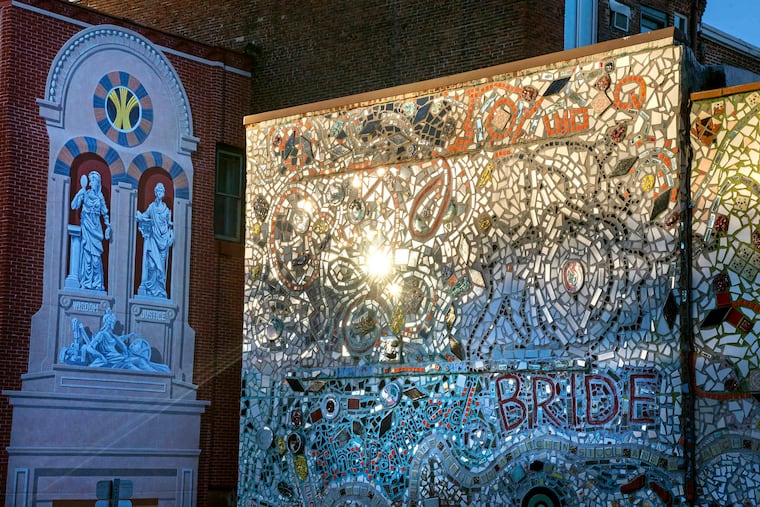Court blocks sale of Painted Bride, citing ‘priceless’ mosaic facade
Judge Matthew D. Carrafiello ruled that sale of the building and destruction of Isaiah Zagar's murals would not be in the best interest of the public.

Philadelphia Orphans’ Court has blocked the sale of the Painted Bride Art Center in Old City, citing the likely destruction of the Bride’s “priceless” mosaic facade, created by artist Isaiah Zagar during the 1990s.
Judge Matthew D. Carrafiello issued his opinion Thursday afternoon, saying the sale would "all but ensure the destruction of what many individuals consider to be a true treasure.”
The Bride, a charitable nonprofit, had sought court approval of its agreement to sell its landmark building at 230 Vine St. to Groom Investments, which has indicated it would erect a condo building with parking on the site.
Groom offered about $4.5 million — enough, Bride officials said, to relieve them of the burden of building ownership. Their plan was to become a nomadic arts presenter, using the sale proceeds as an endowment, and working with arts organizations on projects all over the city.
Jerrold V. “Jim” Moss, attorney for Zagar, had argued in court for a different offer, a $2.3 million bid by Lantern Theater Co., which promised to save the building and its 200-seat performance venue — along with the distinct Zagar mosaics. But that fell $2 million short of the Groom offer, and the Bride rejected it.
“We overcame [the obstacles] because the court agreed with our position that destruction of the artwork would not be in the public interest,” Moss said.
Laurel Raczka, Bride executive director, said Bride leadership was disappointed by the court ruling. The court, she said in an email, had apparently recognized “our need to sell the building to fulfill the Bride’s vision.”
“The artistic value of the Skin of the Bride” — as the Zagar mosaics are sometimes called — “is not comparable to the value of the multiple artists and works we have [supported] and will support.”
She continued: “We are currently reviewing the court’s decision and considering our options. We firmly believe in our vision of providing programming throughout the city, particularly on bringing our resources to all communities.”
In the wake of the court decision, attorney Moss said he hoped that the Lantern Theater bid would now be reconsidered by the Bride.
“$2.3 million is not chicken feed,” he said.
The Bride first announced in 2017 that it planned to sell its building because the cost of building maintenance was prohibitive and the Old City neighborhood had become more friendly to luxury lofts and high-end design studios than to alternative art spaces.
The sale announcement immediately drew fire from a broad swath of the city’s arts community. That opposition came to a head with a petition filed in Orphans’ Court earlier this month seeking the ouster of the Bride’s current board of directors.
Judge Carrafiello said in his ruling that the potential destruction of the Zagar art was at the heart of his decision. Were it not for that, he wrote, he would unquestionably approve the sale. He added that the Bride did not counter the argument that the mosaics were “an irreplaceable work of art,” whose value is priceless.
Judge Carrafiello did not rule on the petition to oust the board.